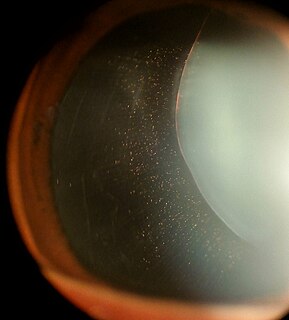 W
WA cataract is an opacification of the lens of the eye which leads to a decrease in vision. Cataracts often develop slowly and can affect one or both eyes. Symptoms may include faded colors, blurry or double vision, halos around light, trouble with bright lights, and trouble seeing at night. This may result in trouble driving, reading, or recognizing faces. Poor vision caused by cataracts may also result in an increased risk of falling and depression. Cataracts cause half of all cases of blindness and 33% of visual impairment worldwide.
 W
WCongenital cataracts refers to a lens opacity which is present at birth. Congenital cataracts cover a broad spectrum of severity: whereas some lens opacities do not progress and are visually insignificant, others can produce profound visual impairment.
 W
WEctopia lentis is a displacement or malposition of the eye's crystalline lens from its normal location. A partial dislocation of a lens is termed lens subluxation or subluxated lens; a complete dislocation of a lens is termed lens luxation or luxated lens.
 W
WGlassblower's cataracts are a form of cataract due to an occupational exposure. They are formed by many years or decades of exposure to infrared radiation while working in the occupation of glass blowing, or working close to hot or molten metals such with metal foundry workers or blacksmiths. Glassblower's cataracts are due to chronic exposure to infrared radiation emitted due to the extreme heating of glass or molten metal. The infrared radiation is absorbed by the iris and lens of the eye. This causes cataracts after decades of exposure. This condition may be prevented by wearing protective glasses while practicing these occupations.
 W
WThe regeneration of the lens of the eye has been studied, mostly in amphibians and rabbits, from the 18th century. In the 21st century, an experimental medical trial has been performed in humans as this is a promising technique for treating cataracts, especially in children.
 W
WMicrospherophakia is a rare congenital autosomal recessive condition where the lens of the eye is smaller than normal and spherically shaped. This condition may be associated with a number of disorders including Peter's anomaly, Marfan syndrome, and Weill–Marchesani syndrome. The spherical shape is caused by an underdeveloped zonule of Zinn, which doesn't exert enough force on the lens to make it form the usual oval shape. It is a result of a homozygous mutation to the LTBP2 gene.
 W
WNance–Horan syndrome is a rare X linked syndrome characterized by congenital cataract leading to profound vision loss, characteristic dysmorphic features and dental anomalies. Microcornea, microphthalmia and mild or moderate mental retardation may accompany these features. Heterozygous females often manifest similarly but with less severe features than affected males.